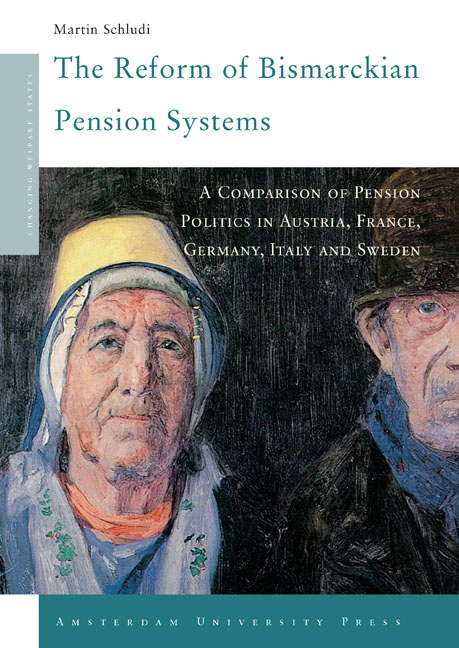 The Reform of Bismarckian Pension Systems
The Reform of Bismarckian Pension Systems Book contents
- Frontmatter
- Contents
- List of Tables/List of Figures
- Acknowledgements
- Introduction
- 1 The Need for Pension Reform:A Problem-Oriented Perspective
- 2 An Empirical Overview of Policy Change in Bismarckian Pension Regimes
- 3 The Politics of Pension Reform:An Actor-Centred Explanatory Framework
- 4 Sweden:Policy-Oriented Bargaining
- 5 Italy:Corporatist Concertation in the Shadow of EMU
- 6 Germany:From Consensus To Conflict
- 7 Austria:Reform Blockage by the Trade Unions
- 8 France:Adverse Prerequisites for a Pension Consensus
- 9 Conclusion
- Appendix I Summary Description of Retirement Systems (1986)
- Appendix II Chronology of National Pension Reforms
- Appendix III Glossary of Terms
- Notes
- Bibliography
- Index
- Frontmatter
- Contents
- List of Tables/List of Figures
- Acknowledgements
- Introduction
- 1 The Need for Pension Reform:A Problem-Oriented Perspective
- 2 An Empirical Overview of Policy Change in Bismarckian Pension Regimes
- 3 The Politics of Pension Reform:An Actor-Centred Explanatory Framework
- 4 Sweden:Policy-Oriented Bargaining
- 5 Italy:Corporatist Concertation in the Shadow of EMU
- 6 Germany:From Consensus To Conflict
- 7 Austria:Reform Blockage by the Trade Unions
- 8 France:Adverse Prerequisites for a Pension Consensus
- 9 Conclusion
- Appendix I Summary Description of Retirement Systems (1986)
- Appendix II Chronology of National Pension Reforms
- Appendix III Glossary of Terms
- Notes
- Bibliography
- Index
Summary
Pension reform is difficult but it happens
Welfare retrenchment is a difficult undertaking. As Pierson (1997) points out, the welfare state appears to be the most resilient aspect of the post-war political economy, with pensions probably being the most resilient part of it. This is particularly true for pension systems of the Bismarckian type covering large sections of the population and granting earnings-related benefits typically perceived as “acquired rights” on the part of the beneficiaries. Nevertheless, most governments in the countries studied have sought to reform their retirement income systems in recent years. In principle, this holds true for both left and right governments, although the experiences in Austria, Germany, and Sweden show that Social Democratic party leaders often had greater difficulties in organising support for painful pension cuts within their own party organisations than did their bourgeois counterparts. Governmental reform efforts in pension policy were mainly aimed at dampening the growth of non-wage labour costs, unburdening the public budget, establishing a tighter link between contributions and benefits, harmonising benefit regulations between different pension schemes and stimulating the expansion of fully funded old age provisions. As far as the goal of cost containment is concerned, the countries studied have made substantial progress since the late 1980s. Pension policymakers in the Bismarckian countries have adopted a number of cost containment measures in recent years. As a consequence, public pension expenditures will now grow much more slowly over the following decades than they would have done otherwise.
Huge differences in national sequences of pension policymaking
However, comparing the national developments conducted in this study also revealed substantial variations around the trend line and, perhaps even more importantly, in the timing and speed of reforms. Among the countries studied, Sweden stands out as the only country that managed to ensure the long-term sustainability of its pension system in one big step rather than in a long succession of numerous more or less piecemeal adjustments.
In Italy, pension policy continued to be expansive rather than contractive until the early 1990s. Thereafter, however, this policymaking pattern changed radically.
- Type
- Chapter
- Information
- The Reform of Bismarckian Pension SystemsA Comparison of Pension Politics in Austria, France, Germany, Italy and Sweden, pp. 219 - 248Publisher: Amsterdam University PressPrint publication year: 2005
